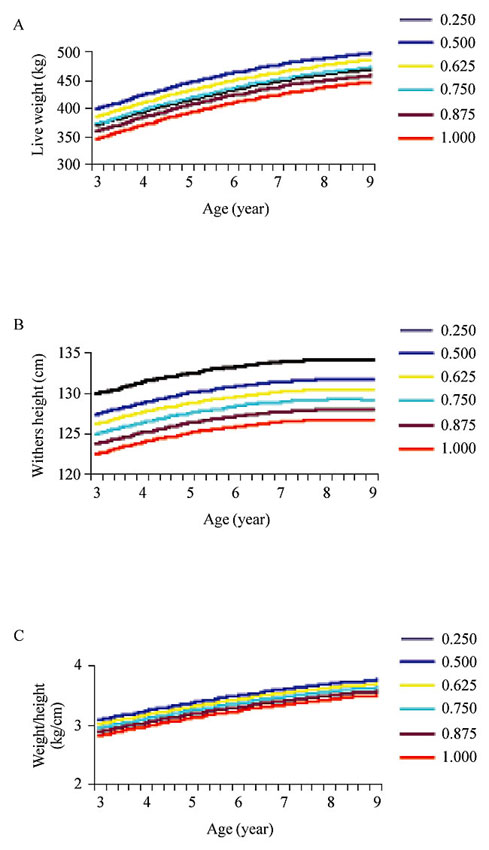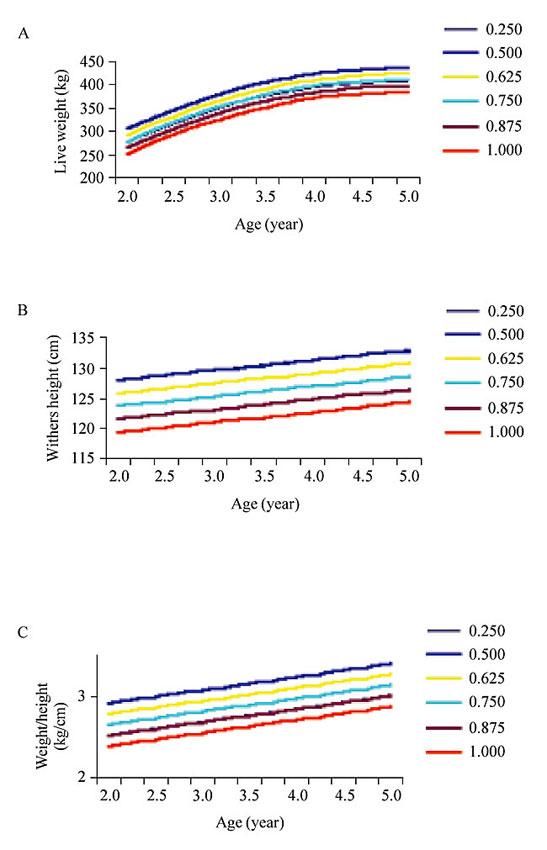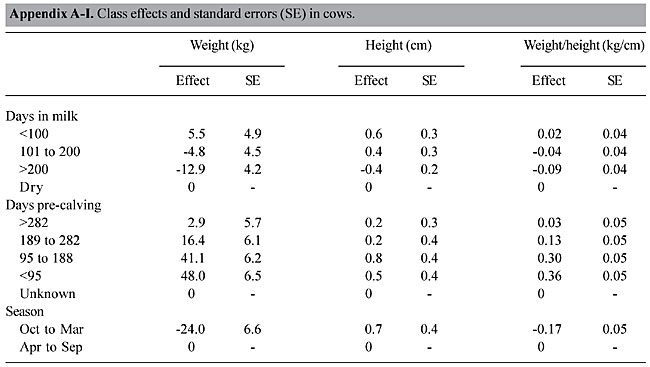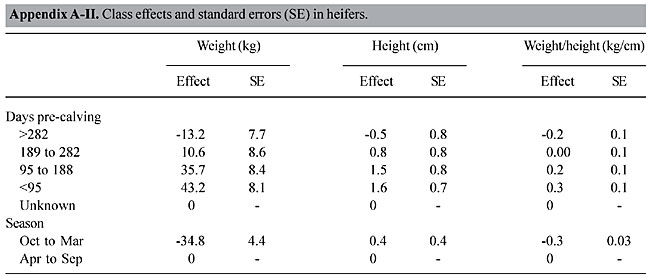
ABSTRACT. Serial data on live weights, height at withers and the weight/height ratio of 263 cows (3 to 9 years old) and 196 heifers (2 to 5 years old) were studied. The animals were of six red and white Holstein-Friesian (HF)/Guzera crosses (1/4, 1/2, 5/8, 3/4, 7/8 and ³31/32 HF-expected gene fraction). Separate analyses were performed for cows and heifers using the Proc Mixed of the SAS package. Models included the fixed effects of farm, season, reproductive and lactation status, two-factor interactions, quadratic regressions on age and age x crossbred group interaction, as continuous co-variables and regressions on the HF gene fraction and on breed heterozygosity, plus the animal random effect. Only heifer growth in height and weight/height was linear with age. In all three traits in both categories the individual additive-dominance model explained the variation between crossbred groups. The breed additive difference was not significant (P > 0.05) for cow and heifer live weight and for heifer weight/age ratio. Heterosis was significant for all traits except height of cows. Linear and quadratic regression coefficients for cows, were, respectively, for live weight, 35.20 ± 5.23 kg/year and -1.54 ± 0.43 kg/year2, for withers height, 2.49 ± 0.29 cm/year and -0.15 ± 0.02 cm/year2 and for weight/height, 0.22 ± 0.04 kg/cm/year and -0.01 ± 0.003 kg/cm/year2. Corresponding values for heifers were, for live weight, 153.46 ± 37.06 kg/year and -15.69 ± 4.91 kg/year2, while only linear coefficients applied to withers height (1.63 ± 0.43 cm/year) and weight/height (0.16 ± 0.03 kg/cm/year). Key words: Holstein-Friesian, Guzera, Weight/height ratio, Growth curve INTRODUCTION Because a high proportion of feed in Brazilian dairy farms is required for maintenance, cow live weight has a strong negative economic weight on farm profit (Vercesi Filho et al., 2000; Martins et al., 2003). Descriptions of live weight changes with age are needed for decision making on planning, selection and crossing. Live weight gain in heifers mainly affects the rearing costs of heifers. Thus, although juvenile and adult weights are biologically related, it is convenient to study them separately for economic considerations and from this perspective there is no need for a unique growth curve suitable for both categories but rather separate curves may be preferable. Linear size measurements reflecting skeleton growth are known to be less affected by temporary environmental factors than is live weight, and have been used to describe growth (e.g., Cartwright, 1979). The weight/height ratio is an indicator of body condition (Klosterman et al., 1968; Nelsen et al., 1985) and has been proposed as a selection criterion to improve feed efficiency (Mason et al., 1957). Herd life in hybrid dairy herds in Brazil is generally very long (Lemos et al., 1996), so changes in female size up to advanced ages are of interest, calling for polynomial rather than asymptotic growth curves. Madureira et al. (2002) described crossbreeding effects on live weight and height of heifers and cows, using data from a comprehensive project on strategies of crossbreeding, in which heifers of six crossbred groups were distributed to 67 co-operator farms for lifetime evaluation (Madalena, 1989, 1993). Here we concentrate on the relationships of those traits with age. MATERIAL AND METHODS Serial data on live weight, height at withers and the weight/height ratio of 263 cows and 196 heifers were studied (only 232 and 167 animals, respectively for height, as some were not measured). The animals were of six red and white Holstein-Friesian (HF)/Guzera (Guz) crosses (1/4, 1/2, 5/8, 3/4, 7/8 and ³31/32 HF-expected gene fraction). The 1/4 cows were sired by 14 Guz bulls, the 5/8 by eight 5/8 bulls and the other four groups by (the same) 12 HF bulls. Heifers were born at the Santa Monica Experimental Farm, State of Rio de Janeiro, between March 1977 and December 1981. They were distributed to co-operator private farms at mean age 22 months and mean weight 220 kg, for lifetime monthly milk recording. With a few exceptions, each farm received a set of six contemporary heifers, one of each crossbred group. The animals were managed according to each farm’s own criteria, with no interference from the research team. The data of the present study were obtained from 50 farms, with easy access, where the weights and heights could be recorded. Those farms were located in the States of Minas Gerais, São Paulo and Rio de Janeiro. Rationale and other trial details were described in previous publications (Madalena, 1989, 1993). There were two portable scales (accuracy 200 g) located at EMBRAPA centers in the States of Minas Gerais and São Paulo. As a rule, dry cows and heifers were fasted for 16 h before weighing (Madalena, 1964). Withers height was measured with a metric rod. With some exceptions, the animals were weighed twice a year, between 1981 and 1987, when the recording was stopped because of lack of funding, once in the dry season (April to September) and once in the rainy season (the other months, but no weighing occurred in January and February). A summary of the available records is shown in Table 1.  1232 cows with 1305 records and 135 heifers with 240 records. For analytical purposes, farms were grouped in classes according to region and management similarity. Reproductive status was estimated by subtracting a standard 282-day gestation length from the calving date and the observations were grouped into five classes according to status on day of weighing (first, second and third 92-day gestation period, empty and unknown, for cows dead/sold before next calving). Four classes of lactation status were considered (up to 100, 101 to 200, >200 days in milk and dry). Separate analyses were performed for cows and heifers using the Proc Mixed of the SAS package. Models included the fixed effects of farm class of region-management, season at weighing, reproductive and lactation status (in cows), season x reproductive status and season x lactation status interactions and polynomial regressions on age (to the highest significant power) and age x crossbred group interaction, as continuous co-variables and regressions on the HF gene fraction and on breed heterozygosity, plus the animal random effect. The later two regressions estimate, respectively, the breed additive difference (gI, HF-Guz) and heterosis (hI) (Dickerson, 1969; Madalena, 2001). Different models were explored by dropping nonsignificant (P > 0.05) polynomial age regression terms and age x crossbred group and other interactions. The goodness of fit of models was assessed by the likelihood ratio test using the profile likelihood (Littell et al., 1996; Vonesh and Cinchilli, 1997) and by examining the regressions of residuals on age. The goodness of fit of the additive-dominance model was assessed by comparison with a model in which the crossbred group classification substituted for the gI-hI regressions, and whenever the likelihood ratio test was significant, by an analysis of variance of the crossbred classification effects on the residuals of the regression model. Once a model was decided upon, it was re-run using restricted maximum likelihood to obtain the final estimates. The Satterthwite option was used to obtain the denominator degrees of freedom for F-tests of fixed effects (Littell et al., 1996). For a matrix Y of j weights on i animals, the linear mixed model was Y = XB + Zu + e, where B represents the vector of fixed effects and u the vector of random animal effects, X and Z being incidence matrixes, u~MVN (0,G), e~MVN (0,R) and V(Y) = ZGZ´ + R. A spatial co-variance structure (SP (pow)) and a compound symmetric (CS) for R were compared according to the Akaike’s information criterion and the Schwarz’s Bayesian criterion, using restricted maximum likelihood (Littell et al., 1996). RESULTS The CS co-variance structure had slightly better fit for all three traits on both categories than did SP and was adopted for all models. The interactions of crossbred group x age were not significant for any trait in both categories (P > 0.05) and were removed from the models. Quadratic curves for age were sufficient to explain growth of all three traits of cows and of live weight of heifers, while heifer growth on height and weight/height was linear with age. The corresponding regression coefficients are in Table 2. 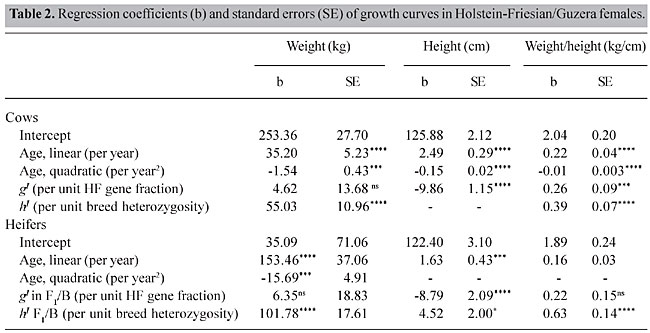 nsP > 0.05, *P < 0.05, ***P < 0.001, ****P < 0.0001. HF = Holstein-Friesian. In all three traits in both categories the individual additive-dominance model explained the variation between crossbred groups, as reported by Madureira et al. (2002). The gI regression was not significant for live weight of cows and for live weight of heifers and for their weight/age ratio (Table 2). Heterosis was nonsignificant only for height of cows. The effects of season, lactation and reproductive status are not discussed as the focus was on age relationships, but they are shown in the Appendix. The quadratic growth curves for the three traits in cows are depicted in Figure 1 and curves for heifers in Figure 2. The maxima of these curves corresponded to ages 11.4, 8.3 and 12.4 years, respectively, for live weight, withers height and the weight/height ratio, with corresponding values shown in Table 3 for each crossbred group. However, only the height maximum was within the actual range of ages studied. Oliveira et al. (1994) reported an asymptotic weight of 455 kg for stud Guz cows, but the maturing rate was lower than in the present study. Perotto et al. (1977) reported estimated asymptotic maxima of 484 and 480 kg for F1 and 3/4 HF-Guz, which were higher than those in our study.
Figure 1. Growth curves of cows of six Holstein-Friesian gene proportions.
Figure 2. Growth curves of heifers of six Holstein-Friesian gene proportions. 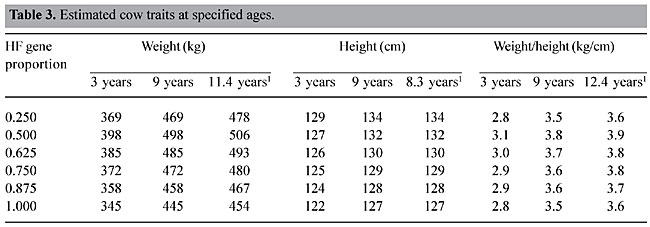 1Ages at maxima of quadratic growth curves (11.4, 8.3 and 12.4 years for live weight, withers height and weight/height, respectively). HF = Holstein-Friesian. REFERENCES Cartwright, T.C. (1979). Size as a component of beef production efficiency: cow-calf production. J. Anim. Sci. 48: 974-980. Dickerson, G. (1969). Experimental approaches in utilizing breed resources. Anim. Breed. Abstr. 37: 191-202. Klosterman, E.W., Sanford, L.G. and Parker, C.F. (1968). Effect of cow size and condition and ration protein content upon maintenance requirements of mature beef cows. J. Anim. Sci. 27: 242-246. Lemos, A.M., Teodoro, R.L. and Madalena, F.E. (1996). Comparative performance of six Holstein-Friesian x Guzera grades in Brazil. 9. Stayability, herd life and reasons for disposal. Braz. J. Genet. 19: 259-264. Littell, R.C., Milliken, G.A., Stroup, W.W. and Wolfinger, R.D. (1996). SAS System for Mixed Models. SAS Institute Inc., Cary, NC, USA. Madalena, F.E. (1964). Técnicas de determinación del peso vivo en los bovinos. Bol. Téc. Est. Exp. “Dr. Mario A. Cassinoni”, Paysandú, Uruguay, 1: 49-54. Madalena, F.E. (1989). Cattle breed resource utilization for dairy production in Brazil. Rev. Bras. Genet. 12 (Suppl.): 183-220. Madalena, F.E. (1993). La Utilización Sostenible de Hembras F1 en la Producción del Ganado Lechero Tropical. Estudio FAO Producción y Sanidad Animal No. 111. Madalena, F.E. (2001). Consideraciones sobre modelos para la predicción del desempeño de cruzamentos de bovinos. Arch. Latinoam. Prod. Anim. 9: 108-117. Madureira, A.P., Madalena, F.E. and Teodoro, L.R. (2002). Desempenho comparativo de seis grupos de cruzamento Holandês-Guzerá. 11. Peso e altura de vacas e novilhas. Rev. Bras. Zootec. 31: 658-667. Martins, G.A., Madalena, F.E., Bruschi, J.H., Costa, J.L. and Monteiro, J.B.N. (2003). Objetivos econômicos de seleção de bovinos de leite para fazenda demonstrativa na Zona da Mata de Minas Gerais. Rev. Bras. Zootec. 32: 304-314. Mason, I.L., Robertson, A. and Gjelstad, B. (1957). The genetic connection between body size, milk production and efficiency in dairy cattle. Dairy Res. 24: 135-143. Nelsen, T.C., Short, R.E., Reynolds, W.L. and Urick, J.J. (1985). Palpated and visually assigned condition scores compared with weight, height and heart girth in Hereford and crossbred cows. J. Anim. Sci. 60: 363-368. Oliveira, H.N., Lôbo, R.B. and Pereira, C.S. (1994). Relationships among growth curve parameters, weights and reproductive traits in Guzera beef cows. Proc. 5th Congr. Genet. Apl. Livest. Prod. Guelph, 19: 189-192. Perotto, D., Castanho, M.J.P., Rocha, J.L. and Pinto, J.M. (1997). Descrição das curvas de crescimento de fêmeas bovinas Guzerá, Gir, Holandês x Guzerá e Holandês x Gir. Rev. Bras. Zootec. 26: 283-288. Vercesi-Filho, A.E., Madalena, F.E., Ferreira, J.J. and Penna, V.M. (2000). Pesos econômicos para seleção de gado de leite. Rev Bras. Zootec. 29: 145-152. Vonesh, E.F. and Cinchilli, V.M. (1997). Linear and Non-linear Models for the Analysis of Repeated Measurements. Marcel Dekker Inc., New York, NY, USA.
|
|
